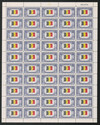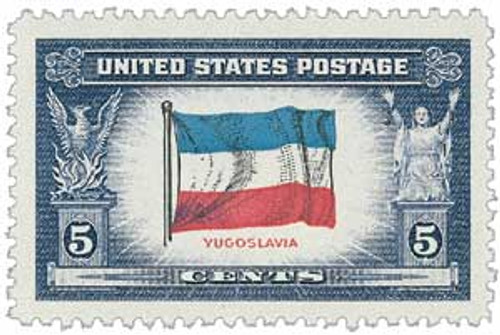
1943 Overrun Countries: 5c Flag of Belgium
# 914 - 1943 Overrun Countries: 5c Flag of Belgium
$0.35 - $19.95
U.S. #914
5¢ Flag of Belgium
Overrun Countries Series
5¢ Flag of Belgium
Overrun Countries Series
Issue Date: September 14, 1943
City: Washington, D.C.
Quantity: 19,999,646
Printed by: American Bank Note Company
Printing Method: Flat-Plate
Perforations: 12
Color: Blue violet, dark rose, yellow, and black
City: Washington, D.C.
Quantity: 19,999,646
Printed by: American Bank Note Company
Printing Method: Flat-Plate
Perforations: 12
Color: Blue violet, dark rose, yellow, and black
U.S. #914 is part of the Overrun Countries Series, which honors each of the nations invaded by Axis powers during World War II. It pictures the flag of Belgium, featuring black, yellow, and red vertical bands. The flag as it appears on the stamp, was adopted in 1831.
Belgium and World War II
The Kingdom of Belgium is a small country, nestled between the Netherlands and France. Belgium has been a nation since 1830, when it gained independence from the Netherlands.
In 1914, Germany invaded Belgium, with much of the fighting of World War I occurring in the western portion of the country. Belgium assumed control of the German colonies of Ruanda-Urundi (present-day Rwanda and Burundi) during the war and retained that control following the war.
Then in 1940, Germany invaded Belgium again in the Blitzkrieg offensive, remaining there until the Allies liberated them in 1944. Following the war, Belgium became one of the founding members of the North Atlantic Treaty Organization (NATO).
These Stamps Brought Hope to Overrun Countries of WW II
After receiving several designs from artists who felt the current U.S. postage stamps were unattractive, President Franklin Roosevelt began to consider the types of stamps he wanted to issue. He sought to show the world that America was in this war to achieve world peace, not military dominance. With this in mind, the President suggested the U.S. issue a series of stamps picturing the flags of all the overrun nations in Europe.
In the border surrounding each flag, Roosevelt suggested picturing the Phoenix – an ancient symbol of rebirth. He believed “It might tell those suffering victims in Europe that we are struggling for their own regeneration.” The other side of each flag pictured a kneeling woman “breaking the shackles of oppression.”
When the time came to print the stamps, the Bureau of Engraving and Printing was unable to print the multiple colors needed for each flag, so the American Bank Note Company received a special contract for this series.
Additionally, a 5¢ denomination – the foreign rate for first class postage – was chosen so the stamps could be used on overseas mail. The stamps were printed in relatively small quantities and were in high demand as soon as they were issued, with stocks across the country running out almost as soon as they were released.
FDR – The Stamp-Collecting President
President Franklin Roosevelt was instrumental in the design and issuance of U.S. #914. Franklin Delano Roosevelt’s mother introduced the future President to stamp collecting at a young age. Throughout his life, he turned to his collection to relax and unwind.
Roosevelt was elected President four times, serving in the nation’s highest office longer than any other chief executive – 12 years. During those 12 years, Roosevelt promoted the importance of stamps by personally approving each of more than 200 stamp designs. This included suggesting topics, rejecting others, and even designing some of the stamps himself. He used U.S. postage stamps to educate Americans about their heritage, to buoy war-weary spirits during World War II, and to send a message of peace and hope as Europe faced the overwhelming task of rebuilding.
U.S. #914
5¢ Flag of Belgium
Overrun Countries Series
5¢ Flag of Belgium
Overrun Countries Series
Issue Date: September 14, 1943
City: Washington, D.C.
Quantity: 19,999,646
Printed by: American Bank Note Company
Printing Method: Flat-Plate
Perforations: 12
Color: Blue violet, dark rose, yellow, and black
City: Washington, D.C.
Quantity: 19,999,646
Printed by: American Bank Note Company
Printing Method: Flat-Plate
Perforations: 12
Color: Blue violet, dark rose, yellow, and black
U.S. #914 is part of the Overrun Countries Series, which honors each of the nations invaded by Axis powers during World War II. It pictures the flag of Belgium, featuring black, yellow, and red vertical bands. The flag as it appears on the stamp, was adopted in 1831.
Belgium and World War II
The Kingdom of Belgium is a small country, nestled between the Netherlands and France. Belgium has been a nation since 1830, when it gained independence from the Netherlands.
In 1914, Germany invaded Belgium, with much of the fighting of World War I occurring in the western portion of the country. Belgium assumed control of the German colonies of Ruanda-Urundi (present-day Rwanda and Burundi) during the war and retained that control following the war.
Then in 1940, Germany invaded Belgium again in the Blitzkrieg offensive, remaining there until the Allies liberated them in 1944. Following the war, Belgium became one of the founding members of the North Atlantic Treaty Organization (NATO).
These Stamps Brought Hope to Overrun Countries of WW II
After receiving several designs from artists who felt the current U.S. postage stamps were unattractive, President Franklin Roosevelt began to consider the types of stamps he wanted to issue. He sought to show the world that America was in this war to achieve world peace, not military dominance. With this in mind, the President suggested the U.S. issue a series of stamps picturing the flags of all the overrun nations in Europe.
In the border surrounding each flag, Roosevelt suggested picturing the Phoenix – an ancient symbol of rebirth. He believed “It might tell those suffering victims in Europe that we are struggling for their own regeneration.” The other side of each flag pictured a kneeling woman “breaking the shackles of oppression.”
When the time came to print the stamps, the Bureau of Engraving and Printing was unable to print the multiple colors needed for each flag, so the American Bank Note Company received a special contract for this series.
Additionally, a 5¢ denomination – the foreign rate for first class postage – was chosen so the stamps could be used on overseas mail. The stamps were printed in relatively small quantities and were in high demand as soon as they were issued, with stocks across the country running out almost as soon as they were released.
FDR – The Stamp-Collecting President
President Franklin Roosevelt was instrumental in the design and issuance of U.S. #914. Franklin Delano Roosevelt’s mother introduced the future President to stamp collecting at a young age. Throughout his life, he turned to his collection to relax and unwind.
Roosevelt was elected President four times, serving in the nation’s highest office longer than any other chief executive – 12 years. During those 12 years, Roosevelt promoted the importance of stamps by personally approving each of more than 200 stamp designs. This included suggesting topics, rejecting others, and even designing some of the stamps himself. He used U.S. postage stamps to educate Americans about their heritage, to buoy war-weary spirits during World War II, and to send a message of peace and hope as Europe faced the overwhelming task of rebuilding.



















